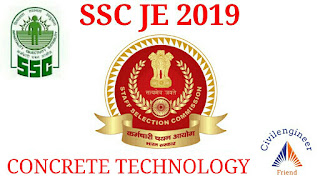div dir="ltr" style="text-align: left;" trbidi="on">
SSC JE 2019 Question and Answers for Concrete Technology
3.1 For one cubic metre of concrete (1: 2: 4), the number of cement bags required is 6.3[SSC: JE: 2011]
3.2 Grading of aggregate in a concrete mix is necessary to achieve reduction of voids [SSC:JE:2011]
3.3 The purpose of concrete compaction is to increase the density [SSC:JE:2011]
3.4 The test strength of the sample is taken as the average of the strength of 3 specimens [SSC:JE:2011]
3.5 The static modulus of e1astcity (Ec) of concrete for short term loading may be derived as Ec=5000 [SSC JE:2011]
3.6 Minimum grade of concrete for moderate environmental exposure condition should be M25 [SSC JE:2012]
3.7 Workability of concrete Is directly proportional to Grading of aggregate [SSC - JE :2012]
3.8 The bottom diameter, top diameter and the height of the steel mould used for slump test are respectively 20cm, 10 cm and 30 cm [SSC.JE :2012]
3.9 The addition of CaCl2 in concrete results in decreased setting time [SSC-JE:2012]
3.10 The concrete mix design is achieved as per IS: 10262 [SSC-JE:2012]
3.11 As per IS: 456 - 2000 the organic content of water used for making concrete should NOT be more than 200 mg/l [SSC-JE:2012]
3.12 The grade of concrete M20 means that characteristic compressive strength of 15 cm cubes after 28 days is not less than 20 N/mm2 [SSC JE :2012]
3.13 Maximum admissible water-cement ratio for mild environmental exposure should be 0.55 [SSC:JE:2013]
3.14 Air entrainment in the concrete increases workability [SSC:JE:2013]
3.15 Which of the following acts as retarder for the concrete? Calcium lignosulphonate [SSC-JE (Forenoon): 2014]
3.16 Identify the wrong statement. Answer is c [SSC - JE (Forenoon): 2014]
(a) Bulking of sand can go up to 40%
(b) Bulking of sand is maximum at 4.6% moisture content
(C) Bulking of sand is considered in weigh batching of concrete mix
(d) Balking of sand occurs due to free moisture film formation over sand grain
3.17 Coarse sand has a fineness modulus in the range of 2.9-3.2 [SSC - JE (Forenoon): 2014]
3.18 The top diameter, bottom diameter and the height of the steel mould used for slump test are 10cm, 20cm, 30cm [SSC - JE (Forenoon): 2014]
3.19 Separation of coarse aggregates from concrete during transportation is known as segregation [SSC -JE(Forenoon): 2014]
3.20 Water-cement ratio Is the measure of water and cement used per cubic meter of concrete weight by weight [SSC - JE(Forenoon): 2014]
3.21 To prevent segregation, the maximum height for placing concrete, is 150cm [SSC - JE (Forenoon): 2014]
3.22 For batching 1:2:4 concrete mix by volume, the ingredients required per bag (50 kg) of cement are 70 liters of tine aggregate: 140 liters of coarse aggregate [SSC - JE (Forenoon): 2014]
3.23 Bulking is increase in volume of sand due to moisture which keeps sand particles apart. (SSC - JE (Forenoon): 2014]
3.24 The concrete cubes are prepared cured and tested according to Indian Standard code IS 516 (SSC - JE (Forenoon). 2014)
3.25 Workability of concrete for a given water content is good if the aggregates are rounded aggregates. (SSC - JE (Forenoon). 2014)
3.26 Generally, strength of concrete is considered negligible very low in Tension [SSC - JE (Forenoon): 2014]
3.27 In concrete, while hand mixing is adopted, excess cement to be added is 10% [SSC - JE (Forenoon): 2014]
3.28 To obtain very high strength concrete, it is necessary to use very tine grained Granite [SSC - JE (Afternoon): 2014]
3.29 The concrete having a slump of 6.6 cm, is said to be plastic [SSC-JE (Afternoon): 2014]
3.30 Calcium chloride added in concrete acts as: accelerator [SSC - JE (Afternoon): 2014]
3.31 The increase in the strength of concrete with time is non-linear (SSC - JE (Afternoon): 2014]
3.32 Workability of concrete is directly proportional to wate cement ratio and grading of aggregate [SSC - JE (Afternoon): 2014]
3.33 The percentage of the aggregate of fineness modulus 2.6 to be combined with coarse aggregate of fineness modulus 6.8 for obtaining the aggregate of fineness modulus 5.4, is 50% (SSC - JE (Afternoon): 2014]
3.34 Generally the ratio of different ingredients (cement, sand and aggregate) in concrete mix of grade M20 is 1: 2: 4 [SSC - JE (Afternoon): 2014]
3.35 Admixture which causes early setting and hardening of concrete is called as Accelerator [SSC - JE (Afternoon): 2014]
3.36 To prevent sulphate attack in concrete, for preparing concrete mix, water pH must be within 6-9 [SSC - JE (Afternoon): 2014]
3.37 For a given aggregate ratio, increasing the water cement ratio: increases shrinkage [SSC - JE (Afternoon): 2014]
3.38 Separation of water, sand and cement from a freshly mixed concrete is known as: Bleeding [SSC - JE (Afternoon): 2014]
3.39 The permanent deformation of concrete with time under steady load is called creep [SSC - JE (Afternoon): 2014]
3.40 An aggregate is known as cyclopean aggregate if its size is more than 75mm [SSC - JE (Afternoon): 2014]







No comments:
Post a Comment
If you are getting more information from civilengineerfriend page please give your comments. Share the page information in your whatsapp group. Subscribe our page to get more information.